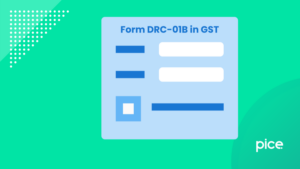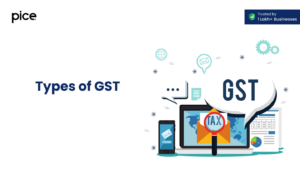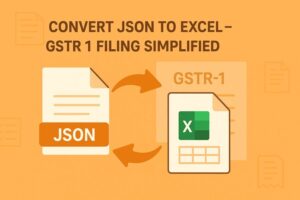How to Surrender GSTIN Number Under GST?
- 16 Oct 25
- 8 mins
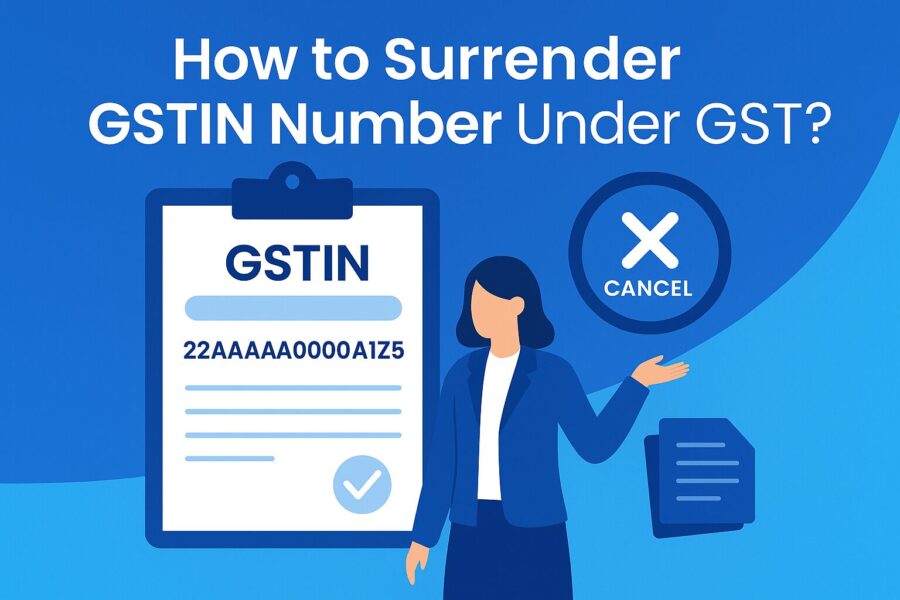
How to Surrender GSTIN Number Under GST?
Key Takeaways
- Businesses can surrender GSTIN number online through the GST portal when annual turnover falls below the GST threshold.
- GST registration cancellation is required in cases of business closure, transfer to non-taxable goods, or voluntary surrender.
- To surrender GST registration, taxpayers must file pending returns, clear tax dues, and submit Form GSTR-10.
- GST registration can be cancelled voluntarily by businesses or compulsorily by GST authorities for non-compliance.
- After GST cancellation, businesses cannot collect tax and must maintain financial records for 6 years under CGST rules.
All businesses whose annual turnover exceeds ₹40 lakhs are compelled by law to have a GST registration to continue their business operations legally in India. Some special category states have a threshold limit of ₹20 lakhs instead of ₹40 lakhs. Once they have their GSTIN number, they must comply with Goods and Services Tax laws in all circumstances.
Running a business is a dynamic process. Sometimes the circumstances fit in a way that having a GSTIN number is neither necessary nor beneficial for the business. In such cases, they might consider to surrender GSTIN number. In this blog, we will further explore why businesses surrender their GST registration and how they can do so.
Reasons for Surrendering GST Registration
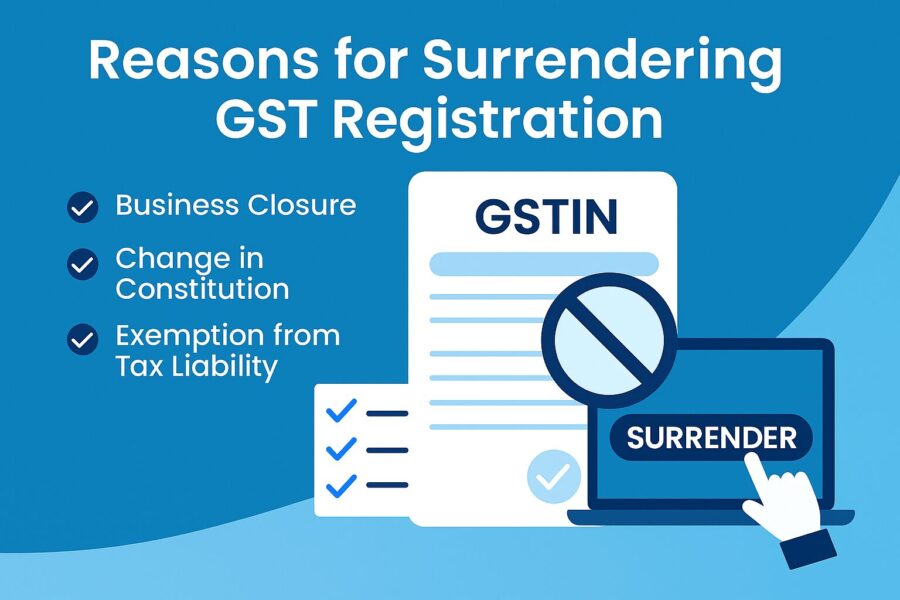
There are many reasons why a business may decide to surrender its GST registration. Business people mostly make this decision after analysing the impact of GST registration closure on their business while considering its compliance and financial burden. Here is a list of these reasons.
Annual Turnover Falling Below GST Threshold
Businesses experience ups and downs in their sales for various voluntary and involuntary reasons. A GST-registered business that is facing a downturn in sales might get sales less than the threshold limit. At this time, the GST registration might feel like a burden to some. This is one of the most prominent reasons why businesses surrender GSTIN numbers.
Business Shut Down
When a business owner decides to shut down their business, surrendering their business’s GSTIN number becomes a procedural step. This legally closes the business’s tax files in front of the GST authorities and frees them of their obligations under the GST Act.
Transferring to a Non-Taxable Business Model
There are instances when businesses decide to change their entire business model from dealing with taxable goods to strictly dealing with non-taxable goods. This makes having a GST registration unnecessary. In such cases, businesses might voluntarily surrender GSTIN number to align their compliance obligations.
Voluntary Surrender
It is common for people to surrender their GSTIN number for their businesses when they are not obligated to have a GST registration as per Goods and Services Tax laws. This helps to reduce some of their burden in complying with their business obligations.
Steps to Surrender GST Registration
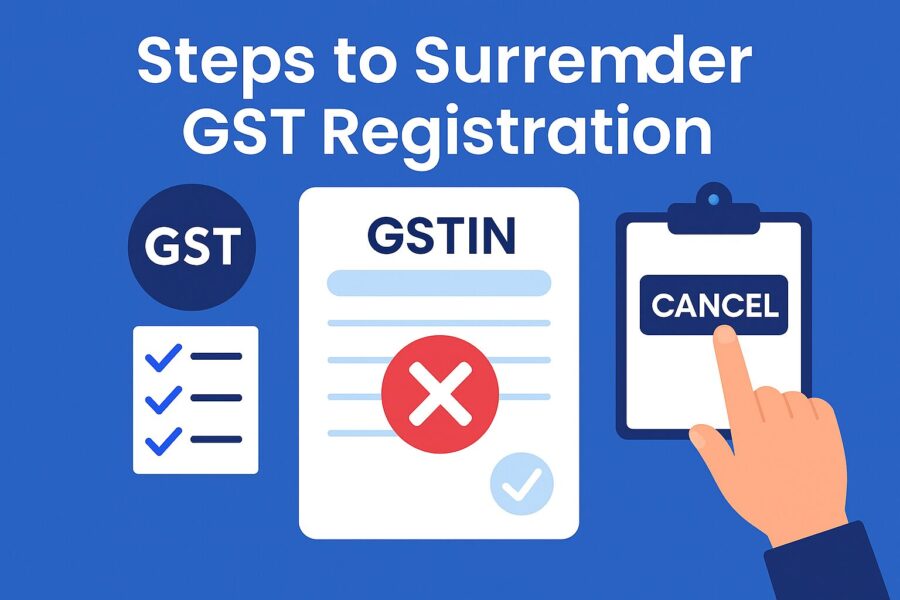
Surrendering your GST registration is a simplified process. You can easily carry out this process online via the GST portal. Here is a step-by-step process on how you can surrender GST registration online.
Step 1: File all your pending return filings and pay your pending taxes. You must also make sure you no longer carry out operations that make you liable to have a GST registration.
Step 2: Keep the ready availability of some documents you will need during the process, and make sure they are duly updated. Here is a list of documents you will need:
- GST Registration Certificate
- Final Return under GST or GSTR-10
- Business Closure Certificate if you are surrendering your GSTIN number due to a business shutdown
- Business merger agreement or transfer agreement documents if you are selling your business or getting into a partnership
- PAN and Aadhaar card number of the authorised signatory
Step 3: Visit the GST portal and log in using your credentials.
Step 4: Click on the Services menu and then select registration, and finally click on Application for Cancellation of Registration. This is a specific form under the Registration Application category.
Step 5: The application for cancellation of registration contains 3 tabs. Make sure that you select the Basic Details tab, which is already set for you by default.
Step 6: Fill out the application form, and in the application, make sure you incorporate a reason for cancellation, the date you select to cease business operations and a clear indication of your wish to nullify your GSTIN number.
Step 7: Upload the required documents, including your annual turnover details.
Step 8: Once you do that, submit your GSTR-10 return file, which is your final GST return and clear any outstanding tax liabilities.
Step 9: You can verify your application using a DSC (Digital Signature Certificate) or EVC (Electronic Verification Code).
Step 10: Once your application is successfully submitted, you will receive your ARN or Application Reference Number via email or message. You can check your GST cancellation status using your ARN.
Step 11: During the cancellation process, a GST officer reviews your application and verifies your documents. If they approve, an order will be issued and your GST registration will be deactivated under applicable CGST Rule guidelines.
Types of GST Registration Cancellation
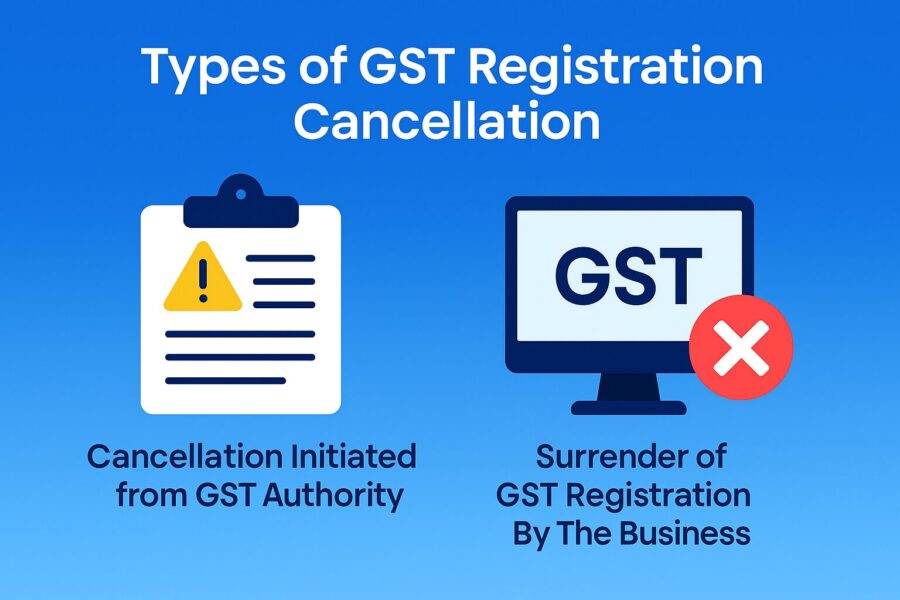
Taxpayers must file for cancellation of GST registration within 30 days of having a circumstance that provides them a reason to request a cancellation. Here are the two most common ways you can lose your GST registration.
Cancellation Initiated Form GST Authority
The GST authority penalises the taxpayer for not complying with Goods and Services Tax regulations. They may suspend or cancel your GST registration for various reasons, such as not filing important return filings like GSTR-3B.
Other reasons for revocation of GST registration number include regular fraud attempts in filing returns. Authorities may ask for an explanation before proceeding to cancel the registration under the framework of the GST Act.
Surrender of GST registration By The Business
Businesses may request a cancellation of their GST registration directly through the GST portal. Business owners do this when they are no longer obligated to have a GST registration and do not find it beneficial either.
However, before GST surrender, they must ensure that they file all their pending returns and pay their remaining taxes.
Legal Effects of Surrendering GST Registration or GSTIN Number
Registering your business for GST is highly beneficial, although it comes with a bunch of tax compliance requirements. Having a GSTIN number brings credibility to your business, boosts your likelihood of availing business loans, and helps customers trust your business.
The legal framework for the cancellation of GST registration streamlines the entire cancellation process and makes it more transparent. However, cancelling GST registration means you no longer collect taxes from your customers. Also, you have to keep a record of your financials for a period of 6 years after the cancellation of your GSTIN number or GST registration, by the CGST Rule.
Conclusion
Taxpayers can surrender GSTIN number when they are no longer legally obligated to have a GST registration, according to GST Act provisions. They must leverage the benefits of GST registration, such as Input tax Credits against their compliance burden.
The process of GST registration and cancellation is very lengthy. Hence, one must seek expert advice before initiating the Registration Application for surrendering their GST registration.
💡If you want to streamline your payment and make GST payments via credit, debit card or UPI, consider using the PICE App. Explore the PICE App today and take your business to new heights.
FAQs
Why would a business surrender its GSTIN number?
How can I surrender my GST registration online?
What documents are required for GSTIN surrender?
GST Registration Certificate
Final Return (GSTR-10)
Business closure certificate (if applicable)
Merger/transfer documents (if applicable)
PAN and Aadhaar of authorised signatory
These documents ensure smooth verification of your GST cancellation request by authorities.
 By
By 













